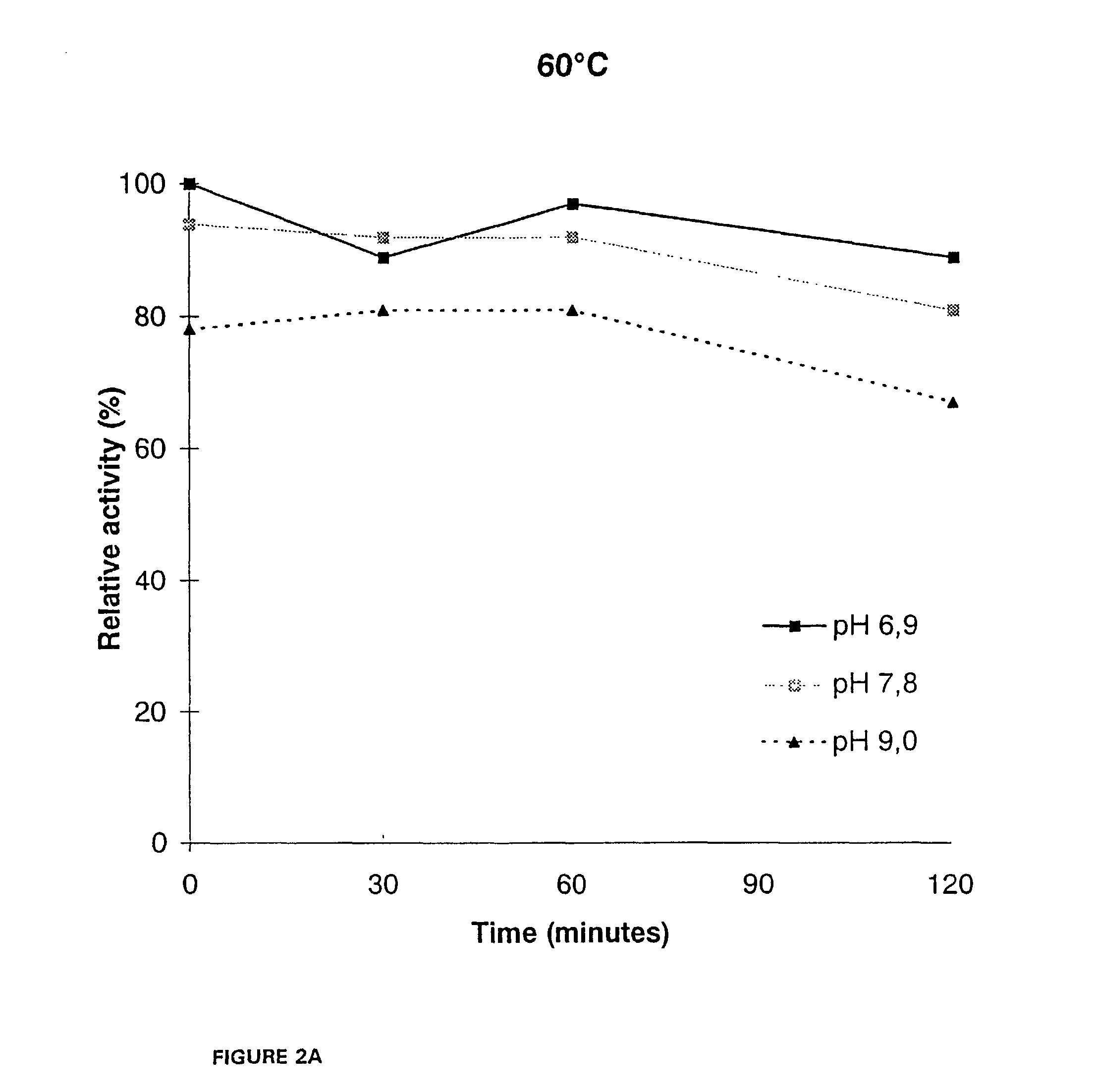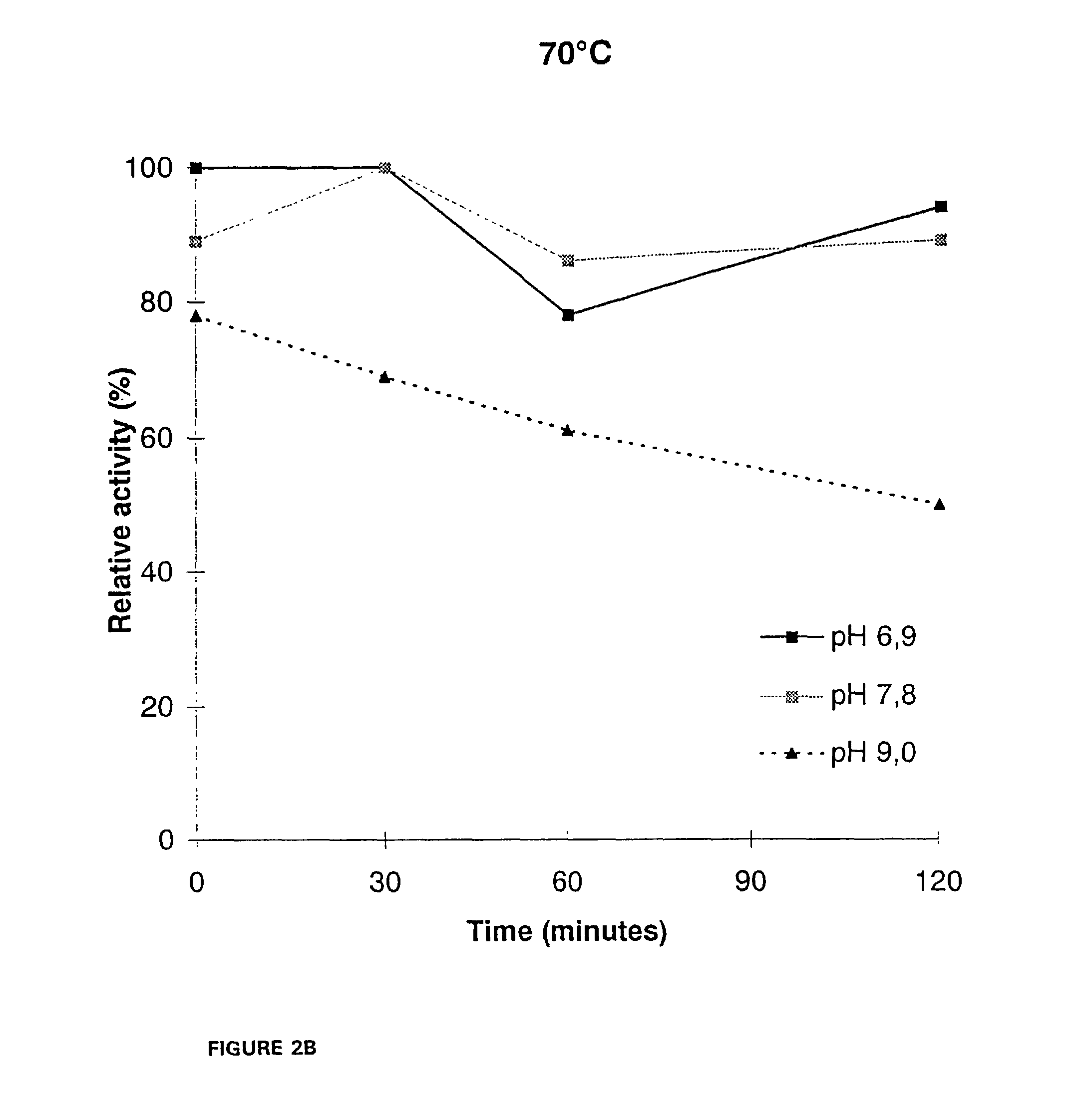Production and secretion of proteins of bacterial origin in filamentous fungi
a technology of filamentous fungi and proteins, which is applied in the direction of cellulose treatment using microorganisms/enzymes, enzymology, organic chemistry, etc., can solve the problems of difficult control of enzymatic lignin degradation, difficult control of other growth, and long treatment tim
- Summary
- Abstract
- Description
- Claims
- Application Information
AI Technical Summary
Benefits of technology
Problems solved by technology
Method used
Image
Examples
example 1
Actinomadura flexuosa DSM43186 Shake Flask and Fermentor Cultivations
[0140]The strain A. flexuosa DSM43186 was streaked on rolled oats mineral medium plate (Deutsche Sammlung von Mikroorganismen und Zellkulturen GmbH [German collection of microorganisms and cell cultures], DSM Catalogue of strains, 3rd ed., Braunschweig, Germany (1983); 1 liter contains 20 g agar, 20 g rolled oats, 1 ml trace element solution containing 100 mg FeSO4×7 H2O, 100 mg MnCl2×4 H2O, 100 mg ZnSO4×7 H2O / 100 ml; pH 9.0) and incubated at 50° C. until sporulating. A sporulating colony was inoculated in 10 ml of XPYB medium (Greiner-Mai, E. et al., System. Appl. Microbiol. 9:97-109 (1987); Holtz, C. et al., Antonie van Leeuwenhoek 59:1-7 (1991)); 1 liter contains 5 g oats spelt xylan, 5 g peptone from casein, 5 g yeast extract, 5 g beef extract, 0.74 g CaCl2×2 H2O; pH 9.0) and was incubated at 55° C. in a rotary shaker (250 rpm) for two to three days. An inoculum of 5 ml was then transferred to 250 ml of the sam...
example 2
Determination of the pH and Temperature Dependencies of Actinomadura flexuosa Xylanase Activity from the Culture Medium
[0143]To determine the pH dependency for the A. flexuosa xylanase activity, samples of the culture medium from the shake flask cultivation (Example 1) were diluted in 50 mM McIlvains buffers (50 mM citric acid-100 mM Na2HPO4) of pH-range 3.0-11.0. The final pH values of the enzyme buffer mixtures were 3.5, 4.5, 5.4, 6.4, 7.2, 8.0, 8.5, 9.7 and 11.2. Xylanase activity was measured at each pH at 50° C., 5 min reaction. The xylanase activity exhibited 80-100% of its maximum activity in the pH range of about 5.4-8.0, showing maximum activity at about pH 6.4 (FIG. 1).
[0144]For, the thermal stability determination, samples from the culture supernatant were diluted in 50 mM McIlvain's buffers. Bovine serum albumin (BSA) was added to a concentration of 100 μg / ml and pepstatin A 10 μg / ml as well as phenyl methyl sulfonyl fluoride (PMSF) 174 μg / ml were added as protease inhib...
example 3
Purification of Actinomadura flexuosa Xylanases
[0145]Purification of xylanases from A. flexuosa growth medium was performed at +4° C. with chromatographic columns coupled to a FPLC apparatus (Pharmacia). Xylanase activity measurements were performed at 50° C. and at pH 6.5. Protein was monitored at 280 nm throughout the purification. Samples were run on polyacrylamide slab gels containing 0. 1% SDS on a Bio-Rad Mini Protean II electrophoresis system and stained with Coomassie Brilliant Blue. A polyclonal antibody prepared against Thermomonospora fusca xylanase A XynA, obtained from Prof. David Wilson, Cornell University, New York) was used to detect A. flexuosa xylanase(s) in Western blots. In the detection, Promega's ProtoBlot AP System was used.
[0146]A growth medium of the two 1 l fermentations described in Example 1 was pooled and centrifuged at 8,000 g for 30 min. The supernatant (1,500 ml) was diluted 1+2 with 12.5 mM Na2HPO4 pH 9 and adjusted to pH 8.6 with 1 M NaOH. This samp...
PUM
| Property | Measurement | Unit |
|---|---|---|
| temperatures | aaaaa | aaaaa |
| temperatures | aaaaa | aaaaa |
| temperatures | aaaaa | aaaaa |
Abstract
Description
Claims
Application Information
 Login to View More
Login to View More - R&D
- Intellectual Property
- Life Sciences
- Materials
- Tech Scout
- Unparalleled Data Quality
- Higher Quality Content
- 60% Fewer Hallucinations
Browse by: Latest US Patents, China's latest patents, Technical Efficacy Thesaurus, Application Domain, Technology Topic, Popular Technical Reports.
© 2025 PatSnap. All rights reserved.Legal|Privacy policy|Modern Slavery Act Transparency Statement|Sitemap|About US| Contact US: help@patsnap.com



